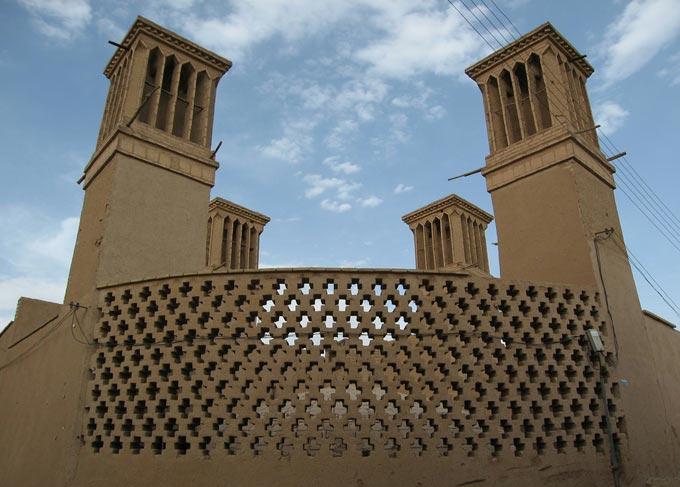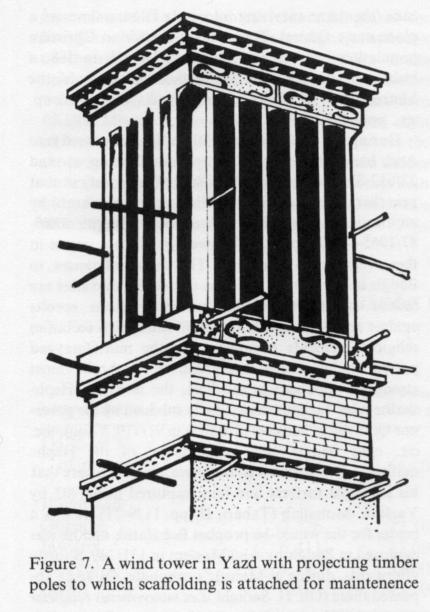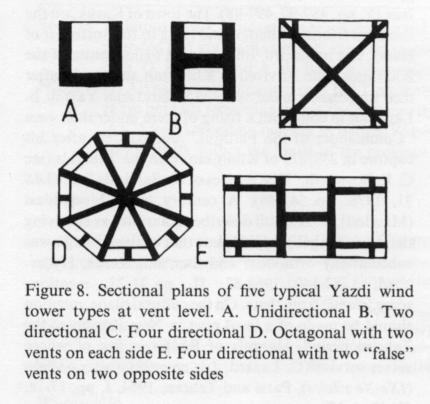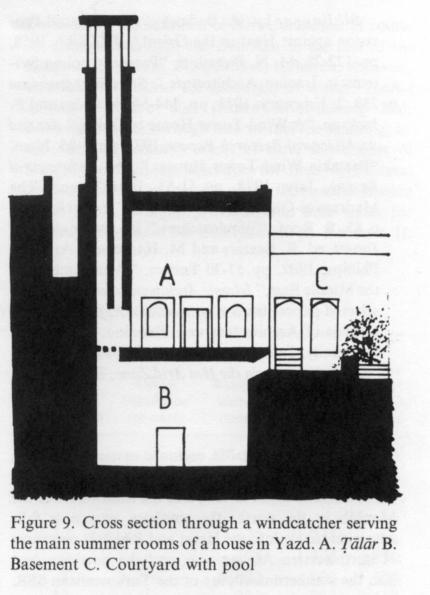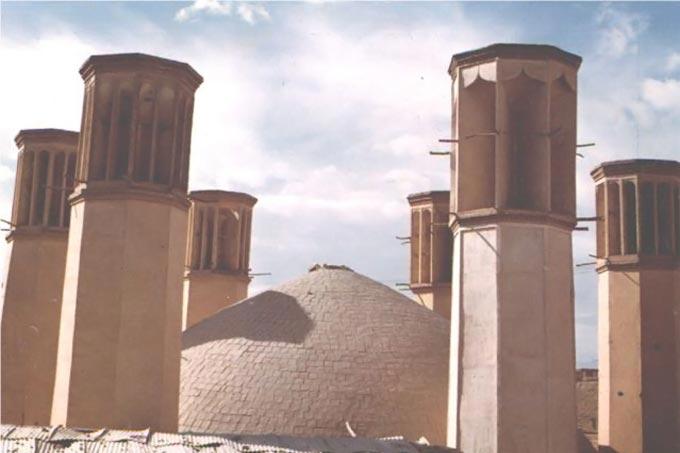This article by Professor S. Roaf first appeared in the Encyclopedia Iranica on December 15, 1988
==================================================================
The Badgir (wind-tower), literally “wind catcher,” a traditional structure used for passive air-conditioning of buildings. Wind catchers are found throughout the Middle East, from Pakistan to North Africa (Coles and Jackson, “A Wind-Tower House in Dubai,” pp. 1-25; idem, “Bastakia Wind-Tower Houses,” pp. 51-53) where they have been built since antiquity.
[Click to Enlarge] A wind tower in Yazd with projecting timber poles to which scaffolding is attached for maintenance (from Encyclopedia Iranica). In construction and design they exhibit a great deal of regional variety but they all perform a similar function (Badawy, pp. 122-28): channeling prevailing winds trapped in vents above the roofs of buildings down to cool and ventilate the rooms below. [Click to Enlarge] Sectional plans of five typical Yazdi wind tower types at vent level. A. Unidirectional. B. Two-directional. C. Four-directional. D. Octagonal with two vents on each side. E. Four-directional with two “false” vents on two opposite sides (from Encyclopedia Iranica). Wind catchers are built in many regions of Iran, predominantly on houses in areas with a hot arid climate. In Bandar-e ʿAbbās and other ports along the Persian Gulf they are normally square towers built on the roofs with vents on one side open to the sea-breezes. [Click to Enlarge] Cross section through a wind catcher serving the main summer rooms of a house in Yazd. A. Ṭālār. B. Basement. C. Courtyard with pool (from Encyclopedia Iranica). Light bamboo screens are often placed across the vents over which water may be thrown on summer afternoons to cool by evaporation the air passing down into the rooms below (Roaf, 1983, pp. 257-68). In Khorasan and Sīstān, rooms have simple unidirectional vaulted vents over them called locally mehna (Tavassoli, p. 49). In the Sīrjān region, houses have distinctive unidirectional barrel-vaulted vents with slatted openings. Ḵūzestān has many fine wind catchers which serve the basements for which towns like Ahvāz are famous. Wind catchers are also built in Shiraz, Isfahan, Tehran, Qom, Semnān, and Dāmḡān but they are most widely used in the cities, towns, and villages to the south of the central desert in the Kāšān, Nāʾīn, Yazd, Kermān, and Ṭabas regions. Yazd is known as “šahr-e bādgīrhā” (the city of wind catchers) and is renowned for the number and variety of its wind catchers, some of which date from the Timurid period (Figure 7) (O’Kane, p. 85). [Click to Enlarge]The world’s sole 6-Badgir water reservoir in the world at the ancient Iranian city of Yazd -تنها آب انبار شش بادگیری جهان-. (Above photo appeared in www.Persian-Star.org). Note also the below summary of the 6-Badgir at Yazd in Persian by the www.Persian-Star.org website: ب انبار شش بادگیر یزد به دلیل دارا بودن شش بادگیر به این نام معروف شده و تنها آب انبار شش بادگیر جهان است. سه بادگیر آن از ابتدا ساخته شده بود و سه بادگیر دیگر بعدها به آن اضافه شده است، با کمی دقت در شکل بادگیرها تفاوت سه بادگیر قدیمی با دیگر بادگیرهای آن را می توان مشاهده کرد. شش بادگیر آب انبار با توجه به شرایط اقلیمی و جهت باد در این منطقه به شکل هشت وجهی هستند. شهر یزد همچنین دارای تنها آب انبار هفت بادگیری جهان با دو مخزن است که در روستای عصر آباد قرار دارد. English Translation: The 6-Badgir water reservoir at Yazd is named as such due to its possesion of 6 Badgirs, the only such water reservoir in the world. The reservoir was first built with three Badgirs with the three other Badgirs constructed later (it is possible to see the differences between the older and newer Badgirs). Note that the Badgirs have been built in an octagon fashion due to considerations of wind patterns and geographical factors. Yazd also has the world’s only seven-Badgir water reservoir (contains two reservoirs) which is located in the village of Asr-Abad. Wind catchers here are brick towers which generally rise from between 30 cm to 5 m above the roof although the tallest bādgīr in the world, built at Bāḡ-e Dawlatābād in Yazd, rises 33.35 m above the roof of the garden pavilion it serves. Wind catchers have vents at the top in one, two, or up to 8 sides (Figure eight) and these vents were decorated in brick, mud plaster or ornately carved lime plaster. The most common use of wind catchers is to cool and ventilate summer living rooms on the ground and basement floors of houses (Roaf, 1982, pp. 57-70); air trapped in the vents of the tower is cooled as it descends and in turn cools the occupants of the rooms below by convection and evaporation (Figure 9). When there is little or no wind, air rises up the tower, the walls of which are heated by the sun, so drawing cool humid air from the courtyard and basement through the summer rooms (Bahadori, pp. 144-54). Ventilation by wind catchers is particularly important in basements which are slept in on summer afternoons and nights. Wind catchers are also built onto the living quarters of caravanserais, over prayer halls of mosques, and on water cisterns where they efficiently chill stored water by evaporative cooling. Bibliography: A. Badawy, “Architectural Provision against Heat in the Orient,” JNES 17, 1958, pp. 122-28. M. N. Bahadori, “Passive Cooling Systems in Iranian Architecture,” Scientific American 239, 2, February, 1978, pp. 144-54. A. Coles and P. Jackson, “A Wind-Tower House in Dubai,” Art and Architectural Research Papers, 1975, pp. 1-25. Idem, “Bastakia Wind-Tower Houses,” The Architectural Review, July, 1975, pp. 51-53. B. O’Kane, “The Madrasa al-Ghiyās²iyya at Khargird,” Iran 14, 1976, p. 85. S. Roaf, “Windcatchers,” in Living with the Desert, ed. E. Beazley and M. Harverson, Aris and Phillips, 1982, pp. 57-70. Idem, “Windcatchers in the Middle East,” Islamic Architecture and Urbanism, selected papers from a symposium organized by the College of Architecture and Planning, King Faisal University, Dammam, 1983, pp. 257-68. M. Tavassoli, Architecture in the Hot Arid Zone, Tehran, 1975, p. 49.

